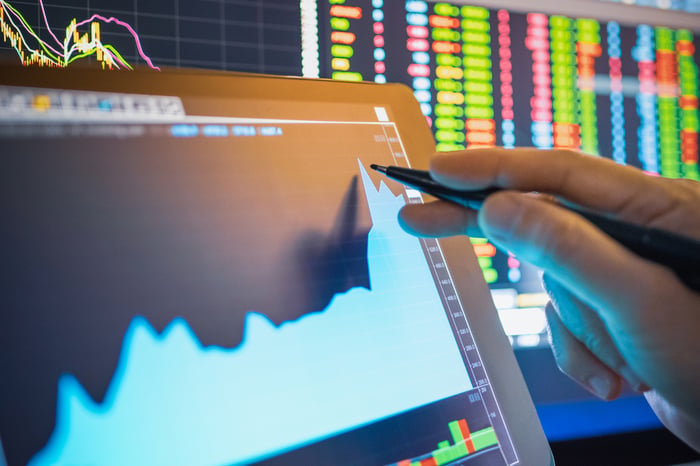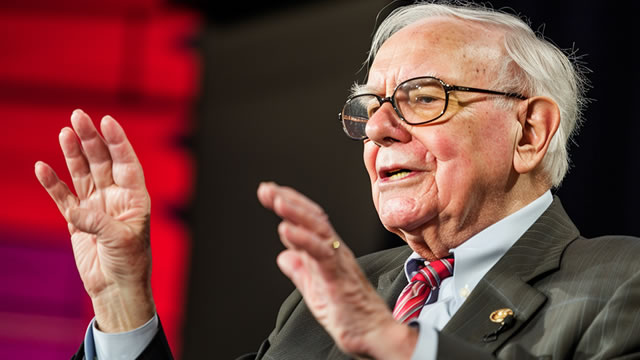For more than two years, Wall Street has been a stomping ground for the bulls. Since the curtain opened for 2023, the mature stock-powered Dow Jones Industrial Average (^DJI -0.37%), benchmark S&P 500 (^GSPC -0.01%), and growth-inspired Nasdaq Composite (^IXIC 0.41%) have respectively rocketed higher by 34%, 58%, and 88%.
Investors haven’t had to dig too deeply for catalysts behind this rally. In no particular order, the current bull market owes its thanks to:
- The rise of artificial intelligence (AI).
- A resilient U.S. economy.
- Better-than-expected corporate earnings.
- A decline in the prevailing rate of inflation from a four-decade high of 9.1%.
- Excitement surrounding stock splits.
- Donald Trump’s return to the White House.

Berkshire Hathaway CEO Warren Buffett. Image source: The Motley Fool.
But as Wall Street has reminded investors for more than a century, when things seem too good to be true, they usually are.
Though the Dow Jones, S&P 500, and Nasdaq Composite all recently hit fresh all-time highs, one time-tested valuation tool, which was once endorsed by billionaire investor Warren Buffett, is also in uncharted territory — but not in a good way.
Wall Street just witnessed the “Buffett Indicator” hit an all-time high
There is no one-size-fits-all definition when it comes to “value.” What one investor considers to be expensive might be viewed as a bargain by another. Nevertheless, there are a handful of tried-and-true valuation tools that investors have relied on over the years to determine whether a stock, or the broader market, is relatively cheap, pricey, or somewhere in between.
Most investors are probably familiar with the price-to-earnings (P/E) ratio, which divides a company’s share price into its trailing-12-month earnings per share. This quick valuation measure tends to work wonders on mature businesses, but it’s not particularly useful for growth stocks or during periods of economic turbulence.
A far better measure of value on Wall Street, according to Berkshire Hathaway‘s (BRK.A -0.33%) (BRK.B -0.19%) “Oracle of Omaha,” is what’s now known as the “Buffett Indicator.” The Buffett Indicator divides the total market cap of all U.S.-traded stocks into U.S. gross domestic product (GDP).
In an interview with Fortune magazine in 2001, Berkshire’s chief referred to the market-cap-to-GDP ratio as “probably the best single measure of where valuations stand at any given moment.”
Warren Buffett Indicator soared to an all-time high of 209% 🚨 For context, it peaked at 140% before the Dot Com Bubble Burst pic.twitter.com/bBiqziD0iG
— Barchart (@Barchart) December 9, 2024
When back-tested to 1970, the Buffett Indicator has averaged a reading of 85%. This is to say the total market cap of all U.S. stocks has averaged 0.85 times as much as U.S. GDP over the last 55 years.
But as you’ll note in the post above from Barchart on social media platform X, the Buffett Indicator is well above its historic norm. Updated for the latest round of U.S. GDP data (which isn’t reflected in Barchart’s post from Dec. 9), this once-touted valuation measure of Buffett’s hit an all-time high of 207.04% on Jan. 22, which is more than 140% above its 55-year mean.
Previous instances of the Buffett Indicator blasting to new highs have portended significant downside for the Dow, S&P 500, and Nasdaq Composite. For instance, this valuation tool had previously peaked at 195.62% on Nov. 7, 2021, which is just two months before the 2022 bear market kicked off and sent all three indexes lower by more than 20%. Prior to this, the Buffett Indicator topped out at 166.56% on Feb. 18, 2020, just prior to the COVID-19 crash.
In other words, history has shown that when Buffett’s prized valuation tool moves well beyond the bounds of its long-term average, trouble follows for Wall Street. This may be why the Oracle of Omaha has been a net seller of stocks for eight consecutive quarters at Berkshire Hathaway, to the tune of $166.2 billion.

Image source: Getty Images.
Warren Buffett wisely thinks long term, and so should you
To be fair, the Buffett Indicator is far from the only ominous metric or data point at the moment. For instance, the S&P 500’s Shiller P/E Ratio is at its third-highest reading dating back 154 years, and U.S. M2 money supply declined in 2023 by a level not witnessed since the Great Depression.
Nevertheless, Warren Buffett regularly reminds investors not to bet against America — and history suggests you heed that advice.
The reason the Oracle of Omaha is a long-term investor is simple: he recognizes the nonlinearity of economic and investing cycles.
For example, Buffett and his top advisors at Berkshire Hathaway are fully aware that recessions are a normal and inevitable aspect of the economic cycle. But rather than try to guess when these downturns will occur, he and his team wisely play the numbers game. Whereas the average recession since the end of World War II has lasted roughly 10 months, the typical economic expansion has endured for around five years. Wagering on the U.S. economy to expand has been, and should remain, a winning bet.
The same can be said for putting your money to work on Wall Street.
It’s official. A new bull market is confirmed.
The S&P 500 is now up 20% from its 10/12/22 closing low. The prior bear market saw the index fall 25.4% over 282 days.
Read more at https://t.co/H4p1RcpfIn. pic.twitter.com/tnRz1wdonp
— Bespoke (@bespokeinvest) June 8, 2023
In June 2023, shortly after the S&P 500 was confirmed to be in a new bull market, the researchers at Bespoke Investment Group published a data set on X that compared the length of 27 separate bull and bear markets in the benchmark index dating back to the start of the Great Depression in September 1929.
Spanning 27 downturns where the S&P 500 shed at least 20% of its value, the average bear market endured only 286 calendar days, or roughly 9.5 months. In comparison, the typical bull market for this widely followed index stuck around for 1,011 calendar days over 94 years, which is 3.5 times longer than the average bear market.
It’s also worth pointing out that if the current bull market in Bespoke’s data set were extrapolated to present day, more than half (14 out of 27) of all bull markets have lasted longer than the lengthiest bear market, which was 630 calendar days in the mid-1970s.
Even if valuation tools accurately portend trouble to come for the stock market, the numbers game strongly favors investors who, like Warren Buffett, think long term.
Financial Market Newsflash
No financial news published today. Check back later.










